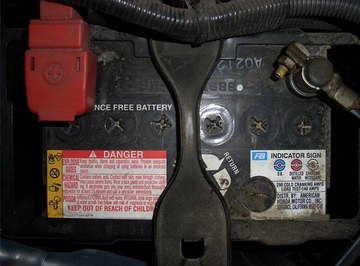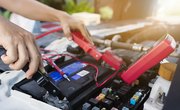
What is a Wet Cell Battery?
A battery is a device that produces an electrical current by means of a chemical reaction. Though the first modern batteries were developed in the 19th century, there is some evidence to suggest crude wet cell batteries were produced at least 2000 years ago in Mesopotamia. As the name implies, a wet cell battery employs a liquid electrolyte-containing medium to trigger a chemical reaction. For example, in a lead acid battery, a liquid electrolyte solution containing 65 percent water and 35 percent sulfuric acid sits in contact with metal plates of lead and lead oxide. When the battery is connected, the acid bonds to the plates in a reaction that also sends an electric current through the attached circuit. If a battery can be recharged through the passing through it of a reversed current, separating the acid from the plates, then it is said to be a secondary battery, or rechargeable. Otherwise, if it is not rechargeable, it is a primary battery. If instead of a liquid solution the battery uses a pasty, less moist material, it is called a dry cell.
Making a Battery
Many school children make rudimentary wet cell batteries every year out of everyday ingredients found in any home. The electrolyte solution is any common non-neutral pH liquid, such as citrus juice (lemon or lime works well) or vinegar for the acids, or ammonia as a base. The other essential materials for making the wet cell are two metals, each of which loses electrons at a different rate. Aluminum foil, which loses electrons easily, becomes the negative terminal, or anode. Copper wire, which does not, becomes the positive terminal or cathode. Place these two metals into the electrolyte liquid with enough of the metal exposed to connect the wires of a circuit. If the metals are brought in contact with the terminals of a DC ammeter, a small electric charge will register.
Applications
The simple wet cell battery made by school children is not very powerful and does not have much real world application. But also, because of their liquid content, wet cell batteries can be fragile and difficult to transport. Also, if they contain caustic material such as acid, they can be dangerous. The most common wet cell batteries in wide use are car batteries, which contain a sulfuric acid solution. It is this so-called battery acid, that is the most dangerous aspect of breaking open the seal or disposing of a car battery. Not only can the sulfuric acid burn the skin badly and produce irritating fumes, the lead used for the batteries terminals is also poisonous. Today, car batteries are a variation of the wet cell called the gel cell. In these batteries, the sulfuric acid solution is mixed with silica to produce a gel-like and immobile material. As a result, the battery is less likely to corrode or to spill hazardous material if inverted or broken in an accident. It also lasts longer since the gel does not evaporate, and can be recharged.
About the Author
Joseph Nicholson is an independent analyst whose publishing achievements include a cover feature for "Futures Magazine" and a recurring column in the monthly newsletter of a private mint. He received a Bachelor of Arts in English from the University of Florida and is currently attending law school in San Francisco.
Photo Credits
Jay Dugger (CC-By-SA 2.0)
